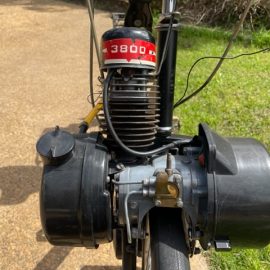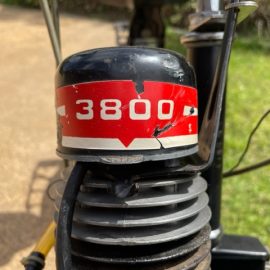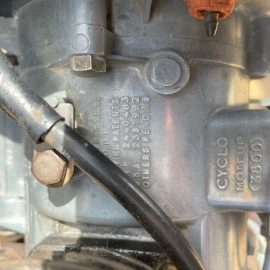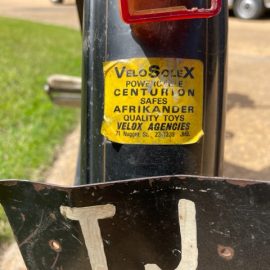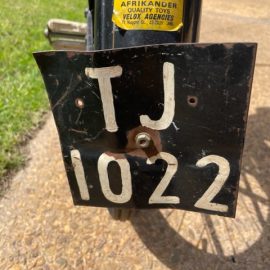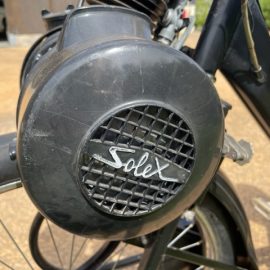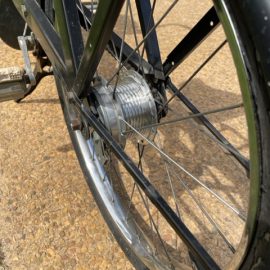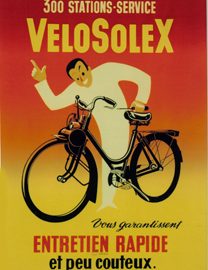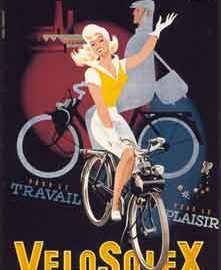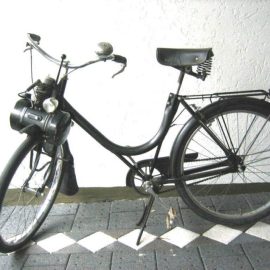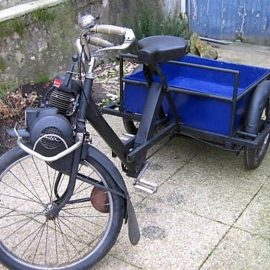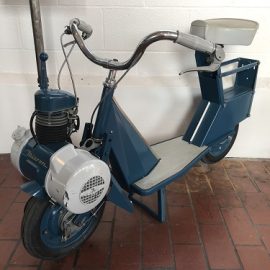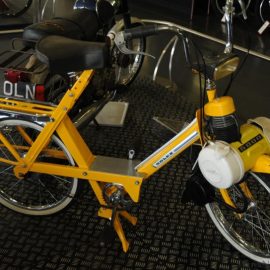
02 Oct On Yer Bike: VéloSoleX
Is it a carburettor, is it a motorbike or is it a moped? No, it’s a Solex, the bicycle that rolls by itself – ‘la bicyclette qui roule toute seule’. This month, FMM Curator Wayne Harley talks foreign…
The VéloSoleX, or as it is more commonly referred to as simply Solex, was the creation of the French company Solex… yes, Solex, the same name many of you must have seen on carburettors over the years. This was one of the company’s main business lines along with micrometers and radiators. It was just after WWII that Solex branched off into the motorised bicycle industry. The intention was obvious: it wanted a cheap, uncomplicated and economical way of getting around and – ‘et voila’ – the VéloSoleX was born.
Introduced in 1946, over seven million of these simple little machines would go on to be produced over the next four decades, originally by Solex in the town of Courbevoie, a suburb of Paris. Ownership would later pass onto Dassault, then Renault and, finally, Motobécane before production was stopped in 1988. Later, the VéloSoleX would again see the light of day and be produced under licence in Hungary and China for a further 17 years before production would once again return to its home country of France, where they are still produced today, albeit only in an electric powered format in keeping with our changing times. The company now offers three different models the VéloSoleX, Solexity and e-Solex, all of which are e-bikes designed for the city commuter, as was the original philosophy.
But I’m getting ahead of myself. The VéloSoleX has a colourful history that has been kept alive by clubs established all around the world including France, Belgium, Germany, the UK and the USA. All of them celebrate this unique little creation that is truly an enjoyable, family-friendly motor-bicycle, from grandparents to grandkids. The original 1946 model was a 45cc single motor-bicycle making only 0,4 hp (0,3 kW), which was followed up in 1953 with the Model 330 that saw the motor capacity increase to 49cc and 0,5 hp (0,37 kW). From 1956 to 1959, four more models – 660, 1010, 1400 and 1700 – were introduced with just slight improvements over the preceding model until the Model 1700 that received an automatic clutch.
The Model S2200 introduced in 1961 would see the engine power increased to 0,7 hp (0,52 kW), and in 1966 the Model S3300 was launched with a square tube frame and a new drum brake on the rear wheel. During the same year the F4 appeared, which was a small scale version of the VéloSoleX fitted with a toy engine that would click-clack like the real thing as little ones peddled themselves around. This led to Solex releasing the Micron in 1968, a model that had no pedals and very small wheels – in some case three. Its purpose was to help with children rider education and was produced in very limited numbers – less than 20 000 were made.
In 1971 Solex finally offered their motor-bicycles in colours other than the standard black. The Model 5000 still only had a 49cc engine but rode on slightly smaller circumference wheels and was available in yellow, blue, orange and white. Included in the Model 5000 range was the folding-frame Plisolex. In 1974 a Model 4600 was added to the VéloSoleX range. Available in orange, blue, yellow and black, they were only available for the export market and never sold in France.
FMM has a rather well used example of a standard VéloSoleX S3800, a model that appeared in 1966 and is the most common and most sold version of the brand over the years It was donated to the Heidelberg Transport Museum by Mr R Cassidy back in May 1985, but what is not known is just how long Mr Cassidy had the motor-bicycle before he donated it. However, from a very original sticker on the rear mudguard it appears he must have bought it from Velox Agencies of 71 Nugget Street in Johannesburg, and from the spec and model type, it must have been purchased in the late-1960s. This S3800 model has the standard front wheel friction drive 49cc motor with a plastic fuel tank, automatic clutch, front and rear brakes and the reduced wheel size. How many of these models made their way to South Africa or for how long they were available isn’t really known. But it certainly offered cheap mobility, a problem we still face today.




